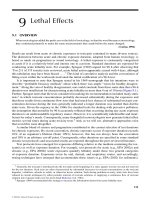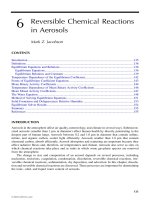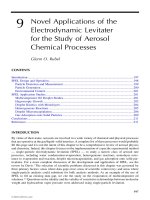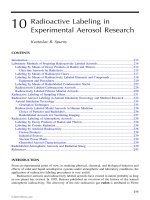Geographic Information Management in Local Government - Chapter 9 docx
Bạn đang xem bản rút gọn của tài liệu. Xem và tải ngay bản đầy đủ của tài liệu tại đây (229.16 KB, 13 trang )
CHAPTER
9
Case Study — Bristol City Council
BRISTOL CITY COUNCIL AT A GLANCE
Key Facts
Local authority name: Bristol City Council
Local authority type: Unitary council
Population: 400,600
Current state of operation of GIS: Multi-supplier/Authority-wide GIS
Main GIS products in use: ESRI’s ArcView (50+ licenses), ArcLLC/ArcInfo (11
licenses), and ArcIMS, SDE, MapObjects, LPGTools (1 license each); also AutoCAD
(50+ licenses), MapInfo (36+ licenses, FastCAD/Map (1 license), ParkMap (28
licenses), and AccMap (4 licenses)
Applications: Map production, gazetteer, local land charges (LLC), development control, engineering, traffic management, parking, lighting, abandoned vehicles, housing,
education, and social services
Land and Property Gazetteer status: Fully operational Local Land and Property
Gazetteer (LLPG) that was developed initially as the National Land and Property
Gazetteer (NLPG) pilot system for the National Land Information Service (NLIS)
GIM/GIS strategy status: Corporate GIM strategy (approved September 1997)
Forum for steering GIS: Geographic information group (GIG) with separate corporate
property group for managing property assets and associated geographic information
Staffing for GIS: No central unit — each department makes its own staffing provision
for GIS
Contact details: Information services manager (telephone 0117 922 3117)
What Makes Bristol City Council Distinctive?
Bristol City Council’s Land and Property Gazetteer (LPG) was the pilot NLPG
that put BS7666 into practice for the NLIS. The Bristol pilot project was begun in
1994 and launched operationally in mid-1998 as a collaborative venture among Bristol
City Council, HM Land Registry (HMLR), Ordnance Survey (OS), and the Valuation
Office (VO). The project focused on streamlining the conveyancing and local land
charges process through the sharing of data among 12 different organizations based
upon a common unit of land and property. The pilot was so successful that the council
©2004 by CRC Press LLC
received awards from the Association for Geographic Information (AGI) and British
Computer Society (BCS). Bristol City Council has capitalized upon the project to its
advantage as the impetus to achieving effective implementation of its LLC system,
GIS, and LPG. The council was the pioneer organization at the forefront of testing
the LLPG concept before the NLPG program was rolled out to other local authorities,
and its experience has significant lessons for others.
Key Stages in the Implementation of GIS
Stage 1 (1989 to 1993) — Early steps in GIS starting with use of AutoCAD within the
engineering and planning functions for manipulation of OS maps and OSCAR street
network data. Development of Bristol’s first street gazetteer (linked to digital mapping), which was used initially by the cleansing system, then as the springboard for
development of the embryo property database using “wheel bins” data.
Stage 2 (1994 to 1998) — Development of business case for LPG and associated
implementation of the computerized LLC system, which created a “head of steam”
for the city council’s lead involvement in the pilot NLPG/NLIS project. Approval of
the council GI management strategy in 1997. Live running of the LLC system and
integral LPG by mid-1998 as part of the pilot project.
Stage 3 (1999 to 2002) — Rollout of Internet-based GIS to all departments modeled
on Bristol City Council’s LPGWeb (Internet-enabled Land and Property Gazetteer,
OS maps, and high-interest spatial data), metadata database (register of datasets
and projects compiled through an extensive information audit), and library (of GIS
and information management standards and how-to-use advice adopted and prescribed by the council). Voluntary registration of the council’s land and property
holdings with the HMLR began in 1999.
Positive Drivers and Success Factors for GIS
•
•
•
•
•
•
•
Strong champions with vision and understanding of information management
principles
High levels of skills and awareness of data management issues by key staff
National pilot project that acted as catalyst to achieving Bristol City Council’s
ambitions
Engineering function’s need for comprehensive street and property data
Planning function’s need for computerized map-based information
Pressure upon LLC service to improve performance
Widespread enthusiasm across departments to use the data available within GIS
Problems that Threatened Success
•
•
•
Major reorganization of Bristol City Council into a unitary authority (April 1996)
Lack of corporate top-down commitment to GIS
Poor appreciation of data management issues by middle management
Practical Benefits from GIS
•
•
•
Improved performance of LLC function
Reduction in duplicated updating and improvement in data quality and updatedness
Improved communication with the public (e.g., faulty light reporting and abandoned
vehicles systems with GIS interfaces)
©2004 by CRC Press LLC
•
•
LPGWeb intranet system facilitated coordination between officers and the public on
problems and activities at an individual property level
Improved communication across the council and with the public and external
organizations
9.1 WHY WAS BRISTOL CITY COUNCIL CHOSEN
AS A CASE STUDY?
Individual local authorities have to decide on their positioning in relation to new
technology projects. While some are keen to take a leading role and to promote
themselves as go-ahead and at the cutting edge, this can often be a lonely, risky,
and uncomfortable position to be in. Many local authorities shrink from being at
the forefront, deciding deliberately to adopt the safer approach of not being a pioneer
and watching and waiting for systems and initiatives to become stable before they
consider implementation.
Bristol City Council is an excellent example of the former — a local authority
that has been keen to be on the crest of the first wave and to become the pilot site
for the NLPG and NLIS. The energy that the council, together with its partners, has
devoted to making a success of the project, has been capitalized upon, enabling it
to put in place very early the framework for coordinating exchange of information
on a land and property basis within the Bristol area. It has also brought kudos to
the city by ensuring that it is clearly seen as far sighted, skilled in land and property
systems, and able to take a leading role in projects of national significance. Bristol
City Council won the AGI award in 1997 for the LPG, and (together with HMLR)
won the British Computer Society award for NLIS in 1998. As background to the
establishment of the NLIS pilot, and the associated benefits that accrued from it in
a local context, this case study has much that is relevant to all local authorities
considering the justification for implementing LLPGs.
9.2
THE BACKGROUND — WHAT HAS BRISTOL CITY
COUNCIL DONE?
Bristol City is a large unitary council with over 16,000 employees within 5 major
departments (central support services; neighborhood and housing services; environment and leisure services; education and lifelong learning, and social services and
health). The council is an example of the implementation of a multi-supplier/authority-wide GIS, using the terminology that we introduced in Chapter 8. The council
has a relaxed policy of allowing each business function to purchase and use the GIS
product that most meets its own requirements.
Products from the following six different GIS software suppliers are in use across
the authority:
©2004 by CRC Press LLC
• ESRI GIS — with ArcView (50+ licenses), ArcIMS/MapObjects (1 license each),
LPG Tools (1 license), ArcLLC/ArcInfo (11 licenses) used across all departments
(for map production, socioeconomic demographics, street lighting, abandoned vehicles, housing management, LLC purposes, and planning application processing)
• AutoCAD (50+ licenses) within central support services, neighborhood and housing services, and environment; transport and leisure (for map production, engineering, 3-D modeling, development planning, landscaping, and property management)
• MapInfo (36+ licenses) within neighborhood and housing services and environment, transport, and leisure (for map production and general business mapping)
• FastCAD/Map (1 license) within environment, transport, and leisure (for map
production and general business mapping)
• ParkMap (1 license) within environment, transport, and leisure (for mapping of
available parking)
• ArcMap (4 licenses) within environment, transport, and leisure (for traffic management and planning purposes)
Development and implementation of GIS has taken place over three major stages:
Stage 1 (1989 to 1993) — Over this period the city council took its first formative
steps in GIS and began to build its expertise in street and property gazetteers. In
1989 the former city engineer’s department (now part of neighborhood and housing
services) began to use AutoCAD for engineering purposes and for the display of
OS digital maps and OSCAR (road-center line) data.
By 1992, the Bristol Street Gazetteer (which had been developed as a text system
in the late 1980s by the research section of the former planning department, now
part of environment, transport, and leisure) was linked to digital mapping (again
using AutoCAD) in order to support the development of a new cleansing system for
the city engineer.
The street gazetteer was subsequently extended to become an embryo property
database using the data available in relation to wheel bins, and began to be used by
other major corporate computer systems. The planning department started to experiment in the use of GIS for map production, plotting of planning applications,
digitizing of local plans, and highways and transport schemes. At the end of 1993,
a major impetus to corporate working was put in place with the setting up of a
second-tier property and land user group (PLUG), which came unanimously to the
conclusion that the prior and overriding need for the future was the implementation
of a central land and property referencing system.
Stage 2 (1994 to 1998) — This was a critical period in the history of GIM within
the city council and is why it is given major attention within this case study. It was
a phase of corporate foundation building during which attention was focused upon
developing the business case for creating the LLPG and computerizing the LLC
service, while working closely in conjunction with external partners. A major stimulus to establishing the council’s infrastructure for holding land and property information came with the coincident publication of BS7666 (see Part 2 of this book —
Specification for a Land and Property Gazetteer), coupled with LGMB’s invitation
to the city council to join the NLIS pilot.
©2004 by CRC Press LLC
Participation in NLIS was seen as an important means to raise the degree of
officer commitment for creating a corporate gazetteer and testing it out in the context
of a new LLC system. The whole thrust of NLIS was to:
• Promote the sharing and exchange of land and property information
• Facilitate access to local and central government information
• Enable the conveyancing process (of which LLC formed a major part) to be carried
out online
The authority had suffered a succession of cuts in resources over recent years
that had placed high priority services under threat. Participation in NLIS was seen
as a means to offset this deterioration in services by:
• Improving information management as an ambitious means to upgrade the quality
of services
• Drawing the attention of politicians and senior managers to the fact that problems
in LPG creation were of national importance and not merely the preoccupation
of particular officers
• Providing the prospect of revenue generation through the marketing of local
authority data, which might offset a substantial element of the cost of LPG creation
and maintenance
Bristol City Council operated within tight financial constraints. It was keen to
develop an LPG compliant with BS7666, but members were insistent that this had
to be funded through the computerization of the LLC service. As a prerequisite this
meant that a business case had to be made that the project would be entirely selffinancing from the revenue and savings that it generated. The desire to comply with
BS7666 was entirely pragmatic at this stage, in that it would:
• Achieve the best opportunity for stimulating the convergence of existing city
council data sets
• Maximize the scope for the exchange of data with other organizations (e.g., via
the NLIS), which was considered to be key to successfully generating revenue
from the information services and achieve a degree of self-financing
The reason for LGMB inviting the city to join the NLIS was to enable field trials
of BS7666 to be carried out in a heavily populated city area. Babtie Consultants
undertook an initial study of the council’s land and property datasets in August 1994.
Using the go-with-the-flow data modeling approach developed by the LGMB, it
identified duplicate data stores, processes, and flows in relation to land and property
that suggested that potential savings were likely to accrue from implementing the
LPG. The study confirmed the intuitive perceptions of Bristol City Council officers
that there was considerable waste and inefficiency in the current systems that could
be overcome through the use of a corporate gazetteer. The study also confirmed in
broad terms, the findings of the earlier Tyne and Wear Joint Information Study in
the 1980s. Disappointingly however, it was unable to quantify the benefits that were
likely to accrue from a corporate gazetteer. The consultants’ report highlighted that
©2004 by CRC Press LLC
of all the council’s services, LLC offered the strongest potential gains from computerization and linkage to the corporate gazetteer as it relied heavily upon the
integration of land and property information from many different sources.
At that time the LLC service was run entirely using manual systems with total
reliance on paper and card index records and not even the use of word processing
facilities. As a result, the processing of 8000 to 9000 searches per year was frequently
faced with frustrating delays. Despite these handicaps, the LLC office (which contained
12 dedicated and experienced staff) was by 1994 achieving a turnaround that was just
quicker than the minimum acceptable level of 10 days. This was due in large part to
the active cooperation of the other directorates that provided information for the
response (in particular the planning directorate) and represented a significant improvement on the average of 20 days to process a search that was typical of the property
boom of the late 1980s. The council was keen to achieve further improvements in
processing speed in the future, particularly if this could be self-financing and result in
the byproduct of a tested corporate gazetteer. However the city council had been subject
to rate-capping for several years and financial controls were stringent. It was clear that
a robust business case would need to be put together covering all aspects of income
and expenditure, both capital and revenue. This was particularly important in the
context of the imminent reorganization of local government, which was to take place
in April 1996 with the Avon County Council and six district councils being abolished
and replaced by four unitary authorities (of which Bristol City was the largest).
In 1995 the council decided therefore to invite tenders for a consultancy study
with the aims of:
• Demonstrating the feasibility (or otherwise) of computerizing the LLC service
• Identifying whether there was a positive case for the use of GIS for LLC processing
TerraQuest Information Management was appointed to undertake the study
(which was funded by an increase in search fees of about £3, levied following
agreement with the Bristol Law Society). The study examined three configurations
for the provision of a computerized LLC system: fully text-based (non-GIS) system,
Windows NT GIS-based system, and Unix GIS-based system. The conclusions of
the study (which are summarized below with the kind permission of Bristol City
Council and TerraQuest Information Management) were that:
• There was a strong business case for computerizing LLC and for each of the three
configurations there was a net positive cash accumulation (at 1994 values) over
5 years (of £419,000 for the text-based system, £296,000 for the Windows NT
GIS-based system, and £93,000 for the Unix GIS-based system). Achievement of
these figures assumed an increase in fees of £20 per search and a staff reduction
of between 5 and 7 staff within the existing team of 12.
• Despite the strong business case, the upfront set-up costs that were to be borne
in Years 1 and 2 through outright purchase were considerably higher than the
council could afford (over £0.5M for each of the configurations, including the
cheapest text-based solution). However, if the council considered leasing, then
these upfront costs could be reduced and “smoothed” over future years, making
leasing an attractive option.
©2004 by CRC Press LLC
Box 9.1
Geographic Information Management and the Eight Es of Good Local
Government
GISs, if properly structured, financed, and supported by effective data management policies,
can have a particular bearing on the eight Es of good local government, for example:
Economy:
by providing better information on economic opportunities, locations of potential
subcontractors and suppliers for incoming firms, facilitating development
proposals, localizing cost center management, etc.
Efficiency:
by reducing duplication of effort in data collection, increased data sharing,
improved timeliness of data
Effectiveness: by providing flexible means of identifying and retrieving relevant and appropriate
information
Equity:
by facilitating the supply of comparative data for geographic areas
Empowerment: by improving the ease of access to appropriate data for those that need it
Excellence:
by facilitating the validation and update of information
Enabling:
by improving the scope for data sharing with outside organizations
Environment: by enabling a more holistic approach to problem-solving and policy formulation;
greater focus on targeted needs; reduction in paper-based messaging and
data storage
Source: From Bristol City Council, “Corporate Strategy for Geographic Information Management,” January 1997.
Based on the results of the consultancy study, the council took the decision to
finance, through leasing, the implementation of a local land charges system. The
authority considered that the potential benefits from a GIS-based system were fundamental to the processing of local land charges searches, and a text-only solution
was discounted. Following open tender in 1996, ESRI was appointed to supply the
Windows NT GIS-based local land charges system, which included the bespoke
development of an integral LPG conforming to BS7666 (as there were no off-the
shelf packages available at this time). The additional costs of delivering and maintaining the gazetteer, estimated at about £120,000, were also rolled into the lease.
In September 1997, the council approved a corporate strategy for GIM with the
objective of using GIS systems and spatial data to support the “eight Es of good
local government” (see Box 9.1). The strategy set out clear principles for the management and sharing of spatial data within the council and introduced mandatory
requirements that all new computer systems holding land and property information
should interface to the corporate LPG, and all existing systems should be migrated
to link to the gazetteer over the next few years.
The LLC system “went live” in April 1998 and was self-financing from the start,
based upon an increase in fees and reduction in staff numbers. The overall project
costs were £1.25M of which £400,000 was for the data capture contract. An immediate benefit of the new system was a reduction in search times from 10 days to
5 days, coupled with increased confidence in the accuracy and completeness of the
search response. The integral BS7666 LPG was developed and tested as part of the
NLIS pilot which was launched in July 1998 and which enabled operational problems
to be debated and resolved in conjunction with Bristol City Council’s partners such
as the IDeA, OS, HMLR, and VO (see Box 9.2). The gazetteer contained about
250,000 basic land and property units, each of which was linked to one of about
6,000 streets. As the prototype for the NLIS, the project was able to demonstrate
clearly the value of the BS7666 Gazetteer (see Figure 9.1) in providing the
©2004 by CRC Press LLC
Box 9.2
The Bristol National Land Information Service (NLIS) Pilot Project
The Bristol NLIS Pilot project was launched in Bristol 1st July 1998 by the Lord Mayor, involving
HMLR, OS, VO and BCC. This enables a number of solicitors to carry out on-line conveyancing
searches and other land and property based searches from data provided by 12 organizations,
through sharing of structured information and GIS. (For more details visit the NLIS website at
.)
The pilot proved that adherence to standards such as BS7666, and subsequent data matching
to a Land & Property Gazetteer (LPG), enables accessibility and promotes sharing of
information which can then be displayed graphically through a GIS. Such was the success of
the pilot, it gained national awards from AGI and BCS. Following this pilot a Concordat, signed
by various Ministers, has stated that all Local Authorities must have an LPG by 2002. These
local LPGs will be part of a national LPG (NLPG) which will allow local authorities access to
NLIS. These initiatives are also seen as means to achieve modernising local government
initiatives from central government such as one-stop shops, call centres, etc.
Bristol regularly receives visitors and requests for presentations and demonstrations from other
local authorities and organizations, which increase as recognition of the Pilot Model’s
application throughout all market sectors grows.
Source: From Bristol City Council, LPG BS7666 Information Audit: A Joined Up GIS Solution,
Report to Management Team, September 1999.
framework for unambiguously pulling together information about a property or plot
of land — both for local land charges and wider conveyancing purposes across 12
different organizations in the Bristol area that are consulted by local solicitors as a
result of a move of house. Based in particular on the work undertaken in Bristol,
the NLIS and associated NLPG programs have now been rolled out to all local
authorities for implementation. The IDeA is heavily promoting NLIS as the first
lead service under the Central Local Government Information Age Concordat.
Citizen
Information Market
Specialist Advisors
Central
Local Government
D.E.T.R.
Street Name & Number
Electoral Role
Valuation Office
NLPG
H.M. Land Registry
Local Taxation
Planning/Bldg.
Royal Mail
Asset Management
Ordnance Survey
Construction Industry
System/Service
Figure 9.1
Utility Companies
NLIS and the NLPG. (From Bruce Yeoman, Bruce Yeoman Associates.)
©2004 by CRC Press LLC
At this point it is worth noting that in 2000, TerraQuest undertook a reappraisal
of how the anticipated costs and benefits contained in the original business case had
translated into reality. This showed that the targeted net positive cash accumulation
had been achieved, and exceeded, through the additional fees income that had
accrued to the trading account due to the increase of searches that had occurred —
up to 12,000 from 1999 to 2000, compared to 9,000 searches that had previously
been assumed. These searches had been dealt with by the reduced level of staff as
envisaged in the business case without detriment to achieving the anticipated reduction in search turnaround times.
Stage 3 (1999 to 2002) — Following the success of the NLIS pilot, this has
been a time of consolidation for the council. Because of their direct experience,
officers of the council remain heavily engaged, together with the IDeA, in supporting
the promotion of NLIS. The council has continued to be involved in closely related
projects and has taken part in the DETR’s trials of the proposed House Buyers/Sellers
Pack. The council has also begun an important project, in support of NLIS, to
voluntarily register its property ownerships with the HMLR (25 to 40% of the city
is owned by the council). Once this project has been completed, anyone who wants
to acquire land or property from the city council will simply be able to obtain a
copy of the title documents from the HMLR rather than having to go through the
current long drawn-out process of having to plough through a time sequence of
related deeds in order to prove title.
In addition, the council has deliberately broadened the focus on GIS away from
LLC to the other service areas that can potentially benefit. Internet-based GIS and
associated access to land and property data have been rolled out to all departments
based on Bristol City Council’s LPGWeb (which is an Internet-enabled gazetteer
linked to OS maps and a high-interest subset of the council’s spatial data: see Figure
9.2). A metadata database (register of spatial datasets and projects) has been compiled
through an extensive information audit of all departments, which is backed up by an
electronic library of GIM standards and how to use advice as prescribed by the council.
9.3 WHAT ORGANIZATION HAS IT SET UP?
In 1993 (following an organizational development study within the council, which
was undertaken by INLOGOV) the first forum for steering and coordinating corporate
working with regard to land and property information was began by organizing the
property and land user group (PLUG) (later renamed the Land and Property Working
Group) which contained second-tier representation from each of the major departments. This group was instrumental in setting the highest priority for the implementation of a central land and property referencing system within the council.
After local government reorganization in 1996, the group was replaced by the
geographic information group (GIG), again at second tier. It was responsible for
setting the overall strategy for, and coordinating the management of, land and
property information within the council and monitoring (at a high level) the implementation of specific projects (such as LLC and corporate GIS). The group was
©2004 by CRC Press LLC
Figure 9.2
(See Color Figure 1 )
Bristol City Council’s Web-based
approach that allows the rapid location of properties of interest by all staff across
its intranet. (From Bristol City Council. Reproduced with permission from Ordnance
Survey. © Crown Copyright NC/03/16653.)
supported by a separate corporate property group that was responsible for putting
in place the framework for the more detailed day-to-day management of information
relating to corporate property interests and assets.
Despite the high profile for GIM within the authority, there is no central unit that
supports departments in the use of GIS and spatial information. Each department has
made provision, as needed for its own resident GIS skills, drawing where appropriate
upon the skills of neighborhood and housing services, which has emerged as a “center
of excellence” in ESRI GIS products (on a charged-for consultancy basis).
9.4 WHAT DOES BRISTOL CITY COUNCIL PLAN TO DO IN
THE FUTURE?
For the future, the council is focusing upon the provision of easily accessible,
low-cost, maintainable GIS for use throughout all departments. The LLPG is currently accessible online by all departments across the council’s intranet. The city
council is now in the process of upgrading its LLC software to the new Total Land
Charges (TLC) module supplied by ESRI, and at the same time upgrading its CAPS
uniform software to Spatial Version 7. The project will bring into one GIS suite an
even wider range of services that previously used different GIS products or had no
GIS facilities at all. This will greatly enhance the degree of interoperability of
systems and the sharing of data. The system as a whole will continue to be underpinned by the corporate LPG, which will now also be delivered through the appropriate uniform module (GMS).
©2004 by CRC Press LLC
The future strategy for GIS in the city council is being reviewed in the context
of an interdepartmental structure that has now stabilized after several years of
reorganizations. It is likely to focus on using CAPS uniform systems as the key
vehicle for the further development of its public interfaces and for meeting the city
council’s e-government targets.
9.5 WHAT WERE THE POSITIVE DRIVERS AND SUCCESS
FACTORS FOR GIS AND GIM?
Bristol City Council has enthusiastically taken the lead on a GIM project of high
visibility and national significance. It has been opportunistic in taking advantage of
an alliance of like-minded external interests to achieve an information infrastructure
that has dramatically improved the way it has been able to deliver land and property
based services. The most important positive drivers that have encouraged the council’s pioneering efforts in GIM have been:
• The climate of cut-backs in services in the early and mid-1990s that forced the
council to be imaginative in looking at how improvements in land and property
information could be used to support enhanced service delivery
• The growing needs within the engineering function for comprehensive street and
property data, and within the planning function for computerized map-based
information
• The increasing recognition of the importance of creating an authoritative corporate
LPG as the means to facilitate an unambiguous exchange of information about a
property or plot of land within the city
• The coincident timing of the publication of BS7666 as the standard for LPGs
• The parallel invitation from LGMB to join the NLIS pilot, which provided access
to external skills and resources
• The push to action from individual champions within the city council that spurred
on the efforts of staff
In addition, a number of critical success factors, have reinforced the above
drivers, to make the project a success:
• Positive interpersonal relationships among all involved in the NLIS project that
contributed to the establishment of a cohesive team
• Benevolent senior management within the council who adopted a hands-off
approach and delegated the key decision making to technically skilled staff
• High levels of skill and an awareness of data management issues within the core
staff that were major advantages in getting new ideas off the ground
9.6 WHAT WERE THE NEGATIVE FACTORS THAT
THREATENED SUCCESS?
Despite the long list of drivers and success factors for the project, there were a
number of negative factors that potentially threatened success:
©2004 by CRC Press LLC
• The constant undercurrent of reorganization, which introduced an air of change
and uncertainty across the council
• Lack of commitment of resources to GIS from the top level, despite an awareness
of the potential benefits
• Preoccupation of middle management in satisfying short-term information needs
at the expense of longer-term investment in the infrastructure
9.7 WHAT HAVE BEEN THE PRACTICAL BENEFITS?
GIS and improved GIM in Bristol City Council has delivered a wide range of
benefits:
• Computerization of LLCs has been achieved on a self-financing basis (see Section
9.2) and has resulted in response times being more than halved (to 5 days
immediately following computerization, and now down to 3 days per search)
despite a 50% reduction in staff. This happened over a period when volumes rose
by 55% from 9,000 searches per annum prior to computerization to 14,000
searches per annum.
• The LLPG is now in wide use throughout the council, enabling the exchange of
information about properties and plots of land on a common basis. The LPGWeb
that operates over the council’s intranet is heavily used by all departments to
identify streets, properties, and plots of land and obtain associated information.
• The wider benefits from the publication of data for use by different systems is
yet to be realized, but early experience of the Lighting Web System has resulted
in reduced duplication of effort, increase in officer time through efficient access
to information, and improved quality of information for decision making.
• The metadatabase is improving efficiency and effectiveness by reducing the time
required to locate and obtain information.
• Systems designed for use by members of the public (see Faulty Light Reporting
and Abandoned Vehicles Reporting at www.bristol-city.gov.uk) make practical use
of the LLPG, and enable structured information to be rapidly entered.
• GIS and the LLPG are providing improved communication channels, enabling
quick and efficient access to information both within the council and in its dealings
with the public and external agencies.
• Participation in the NLIS pilot has ensured that the council is seen as dynamic
and go-ahead and has been widely publicized as such but in a way that is firmly
rooted in achieving practical improvements in services for its own residents.
9.8 WHAT ARE THE LESSONS FOR OTHERS?
Most authorities shrink from being at the cutting edge of technological developments, but they would find it extremely difficult to move forward without being
able to follow local authorities such as Bristol City Council that have relished the
pioneering role. As the local authority that has been the focus of the NLIS pilot,
this case study of Bristol City Council has a number of very important messages
for others:
©2004 by CRC Press LLC
• For those few local authorities that are keen to become pioneers, the case study
makes clear how important it is to ensure that there is a sufficiently strong and
burning need to undertake developments that currently do not exist or have not
been fully tested in order to make the added risk worthwhile. When this is so,
experimental projects can often provide the route to enlisting external resources
that would not normally be available and making things happen in a shorter time.
• For those many local authorities that prefer to watch and wait, the NLIS pilot
study is well documented (see www.nlis.org.uk) and the NLIS and NLPG programs that are currently being rolled out have incorporated many of the lessons
learned through the experiences of Bristol City Council. The key messages to
such authorities are:
• To consider and review the call to participate in the NLIS and the NLPG
programs but to follow Bristol City Council’s example and do so, first and
foremost, in a way that ensures that local benefits are rapidly obtained from
the improved ability to compile and exchange land and property information.
• To derive the highest possible benefits from participating in NLIS and NLPG
versus the costs by fully capitalizing, as Bristol City Council has done, upon
the land and property data that has been expensively collected (and the supporting infrastructure that has been put in place) by ensuring that it is widely
accessible across the local authority and from outside.
©2004 by CRC Press LLC









